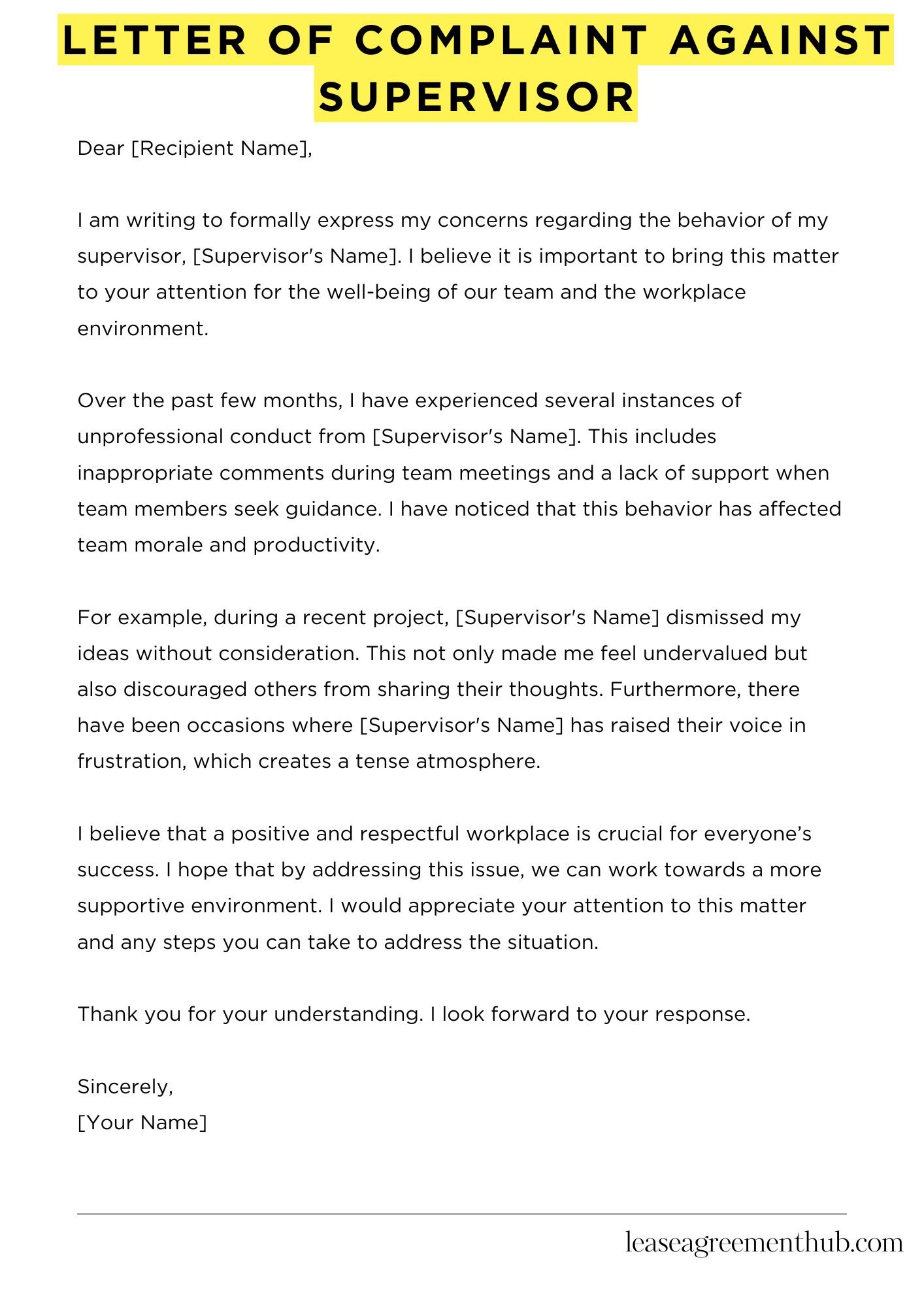A Letter of Complaint Against a Supervisor is a formal document expressing concerns about a supervisor’s behavior or actions. Its purpose is to address issues that affect the workplace environment, employee morale, or job performance. This letter serves as a way for employees to voice their grievances and seek resolution.
In this article, we will provide various templates and examples of a Letter of Complaint Against a Supervisor. These samples will help you craft your own letter with ease. You can adapt them to fit your specific situation and ensure your concerns are clearly communicated.
Writing a complaint letter can be daunting, but it doesn’t have to be. With the right guidance and examples, you can express your thoughts confidently. We aim to make this process straightforward and effective for you.
Letter Of Complaint Against Supervisor
[Your Name]
[Your Address]
[City, State, Zip Code]
[Email Address]
[Phone Number]
[Date]
[Recipient Name]
[Company Name]
[Company Address]
[City, State, Zip Code]
Dear [Recipient Name],
I am writing to formally express my concerns regarding the behavior of my supervisor, [Supervisor’s Name]. I believe it is important to bring this matter to your attention for the well-being of our team and the workplace environment.
Over the past few months, I have experienced several instances of unprofessional conduct from [Supervisor’s Name]. This includes inappropriate comments during team meetings and a lack of support when team members seek guidance. I have noticed that this behavior has affected team morale and productivity.
For example, during a recent project, [Supervisor’s Name] dismissed my ideas without consideration. This not only made me feel undervalued but also discouraged others from sharing their thoughts. Furthermore, there have been occasions where [Supervisor’s Name] has raised their voice in frustration, which creates a tense atmosphere.
I believe that a positive and respectful workplace is crucial for everyone’s success. I hope that by addressing this issue, we can work towards a more supportive environment. I would appreciate your attention to this matter and any steps you can take to address the situation.
Thank you for your understanding. I look forward to your response.
Sincerely,
[Your Name]

How to Write Letter Of Complaint Against Supervisor
Understanding the Purpose of Your Complaint
Writing a letter of complaint against a supervisor is a serious matter. It is essential to understand why you are writing this letter. Are you facing harassment, unfair treatment, or unethical behavior? Clearly defining your purpose will help you communicate your concerns effectively. Remember, this letter is not just a venting tool; it is a formal document that may lead to actions being taken.
Gathering Evidence and Documentation
Before you start writing, collect all relevant evidence. This may include emails, messages, or notes from meetings. Document specific incidents that illustrate your concerns. The more detailed your evidence, the stronger your case will be. It is crucial to present facts rather than emotions. This approach will help ensure your complaint is taken seriously.
Structuring Your Letter Properly
Your letter should have a clear structure. Start with your address and the date at the top. Then, include the supervisor’s name and position followed by the company’s address. Begin with a formal greeting. In the first paragraph, state your purpose clearly. Use subsequent paragraphs to elaborate on your concerns, providing specific examples and evidence. Finally, conclude with a request for action or resolution.
Maintaining a Professional Tone
It is vital to keep your tone professional throughout the letter. Avoid using aggressive or emotional language. Instead, express your concerns calmly and respectfully. This will help you maintain credibility and increase the chances of your complaint being taken seriously. Remember, your goal is to resolve the issue, not to create more conflict.
Reviewing and Sending Your Letter
Once you have drafted your letter, take the time to review it carefully. Check for spelling and grammatical errors. Make sure your points are clear and concise. It may also be helpful to have a trusted colleague read it before sending. When you are satisfied with the final version, send it through a formal channel, such as email or a printed copy, depending on company policy.
Related: